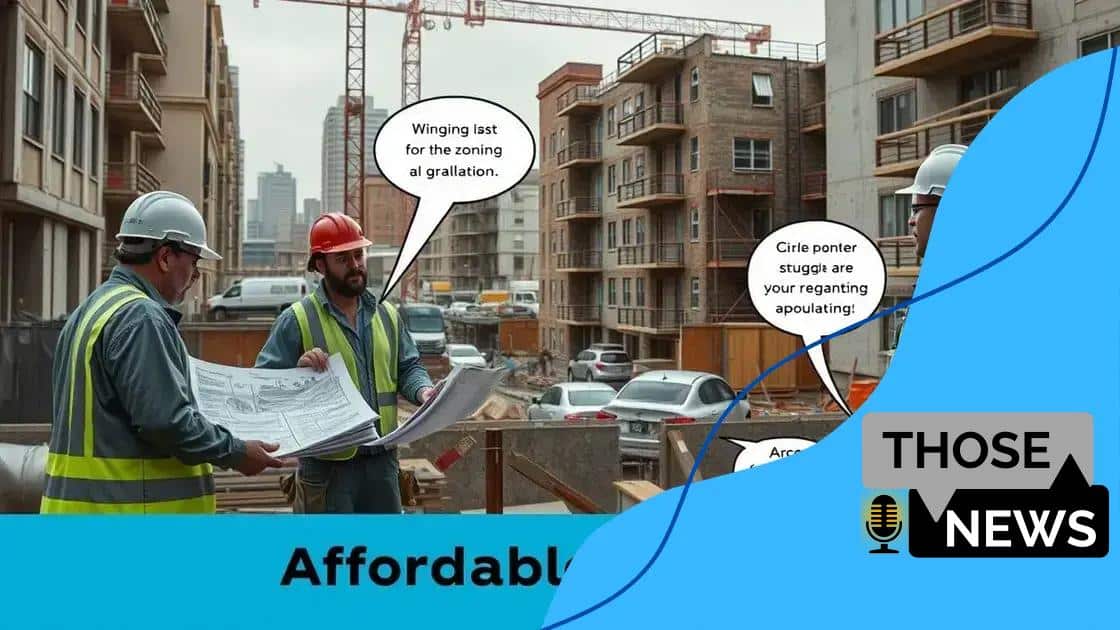Expanding access to affordable housing under new federal policies

Expanding access to affordable housing under new federal policies aims to increase housing availability, stimulate economic growth, and enhance community stability while addressing challenges like high costs and regulatory hurdles.
Expanding access to affordable housing under new federal policies is more than just a phrase; it’s a crucial step towards ensuring all families can find a home. Have you ever wondered how these changes might affect your community? Let’s dive in.
Understanding the new federal policies
Understanding the new federal policies is key to grasping how they will reshape the landscape of affordable housing. Recent changes aim to make housing more accessible for everyone.
This shift comes as a response to increasing housing costs and a growing demand for affordable options. As these policies roll out, they promise to bring significant change to communities across the nation.
Key Features of the New Policies
The new federal policies introduce several important features that aim to tackle the housing crisis head-on. These include:
- Increased funding for affordable housing projects.
- Tax incentives for developers who prioritize low-income housing.
- Streamlined regulations to speed up the construction process.
- Expanded eligibility for housing assistance programs.
Each of these components plays a crucial role in not only increasing the supply of affordable homes but also in ensuring that these homes are built in a timely manner. The policies encourage developers to engage more with communities, fostering partnerships that can lead to innovative housing solutions.
Impact on Communities
Communities will see various impacts as these policies take effect. More affordable housing means less strain on local resources, and it can help stabilize neighborhoods. When families have access to stable, affordable housing, it contributes to their overall well-being.
Many community leaders express optimism regarding these changes, seeing them as a pathway to healthier, more vibrant neighborhoods. As families settle into new homes, we can expect to see positive shifts in local economies and social structures.
Key benefits of affordable housing expansion
The expansion of affordable housing brings numerous benefits to communities, families, and local economies. With more affordable options available, families can find homes that fit their budgets.
Having access to affordable housing creates stability for families, allowing them to invest in education and health. This stability makes a real difference in their daily lives.
Economic Benefits
Affordable housing expansion contributes to economic growth. It increases the spending power of families as they have more disposable income for other essentials.
- Boosts local economies: More residents in affordable housing mean more customers for local businesses.
- Creates jobs: Construction of new housing units generates job opportunities.
- Increases tax revenue: More homes lead to higher property taxes, benefiting community services.
The benefits extend beyond immediate economic impact. By investing in affordable housing, communities can reduce homelessness and related social issues, which helps everyone.
Social Benefits
Affordable housing also fosters a sense of community and belonging. When families live in stable, affordable homes, they are more likely to engage in local activities and build relationships with neighbors. This engagement strengthens communities.
Furthermore, children in stable housing are more likely to perform better in school. They have a chance to focus on their education rather than worrying about housing instability. This long-term investment in children pays off as they grow into productive adults.
Expanding access to affordable housing improves the overall quality of life. It allows families to thrive, contributing to more vibrant and resilient neighborhoods.
Challenges facing affordable housing initiatives

Affordable housing initiatives face a range of challenges that can hinder their success. Understanding these obstacles is crucial for stakeholders looking to make a real impact.
One major challenge is the high cost of land. As cities grow, suitable land for development becomes more expensive. This drives up the overall cost of housing projects, making it harder to offer affordable prices.
Regulatory Hurdles
Additionally, many developers encounter regulatory hurdles. Complex zoning laws and lengthy approval processes can slow down projects, delaying much-needed affordable housing.
- Strict zoning regulations: These laws often limit where affordable housing can be built.
- Lengthy permit processes: Delays in obtaining necessary permits can stall development.
- Funding restrictions: Limited funding options can restrict the scope of eligible projects.
Local governments may also struggle with balancing community interests. Some neighborhoods resist changes, fearing that new developments may alter their character.
Funding Challenges
Another serious challenge is securing adequate funding. Many affordable housing initiatives rely on public and private funding, which can be inconsistent. This uncertainty makes it difficult for developers to commit to long-term projects.
Moreover, the lack of federal support can complicate funding strategies. Without stable funding, projects may fall through, further limiting the availability of affordable housing options.
These challenges require innovative solutions and collaboration among various stakeholders. Addressing them is essential to ensure that affordable housing initiatives can thrive and effectively meet community needs.
Community response to policy changes
The community response to policy changes regarding affordable housing often varies. Many residents have different perspectives depending on their needs and experiences. Some welcome these changes, seeing them as a chance to improve their living conditions.
People in need of affordable housing typically express hope. They believe that the new federal policies will lead to more available units and less competition for housing. For them, having access to affordable housing means stability for their families.
Concerns from Current Residents
However, not everyone is enthusiastic. Existing residents may feel anxious about increased development in their neighborhoods. They worry that new projects might lead to rising property values and, consequently, higher rents.
- Fear of gentrification: Long-time residents may believe that new developments could push them out.
- Loss of community character: Changes in housing can alter the cultural landscape of neighborhoods.
- Infrastructure strain: New developments might burden local services, such as schools and transportation.
Community meetings often serve as a platform for residents to voice their opinions. It is common for people to express both support and concern in these gatherings. Creating a space for discussion helps bridge the gap between policymakers and residents, leading to better solutions.
Opportunities for Collaboration
Effective communication is crucial to addressing these responses. Developers can engage with community members early in the planning process. By doing so, they can gain valuable insights and foster trust among residents.
Collaboration between local governments, non-profits, and community organizations is essential. Together, they can work to ensure that new policies genuinely meet the needs of the community without disregarding existing residents.
By considering the varying responses to policy changes in affordable housing, stakeholders can develop strategies that promote inclusivity and address concerns. Such approaches will ultimately help build stronger communities.
Future outlook for affordable housing market
The future outlook for the affordable housing market is a topic of great interest and concern. As federal policies take effect, many hope for positive change that can make a real difference in communities.
Experts predict that with the right measures in place, the affordable housing market could see a significant increase in available options. A focus on sustainable development is essential, as it ensures that new housing meets both current and future needs.
Innovations in Construction
The use of innovative construction methods can help reduce costs. For example, modular building techniques allow for fast and efficient construction. This can lead to quicker turnaround times for available housing.
- 3D printing: This technology may provide a cost-effective solution for building homes.
- Eco-friendly materials: Sustainable materials can reduce the environmental impact of new homes.
- Community involvement: Engaging residents in the design can lead to better outcomes.
As new technologies develop, they will play a crucial role in shaping the market. Embracing these innovations can help bridge the gap between supply and demand.
Policy Impacts
Continued support from both federal and state governments is vital. Policies that provide financial incentives for developers can stimulate growth in the affordable housing sector. This could encourage investment in areas that need it the most.
Moreover, public-private partnerships may emerge as a successful model. By collaborating, these entities can create comprehensive solutions that meet the needs of communities while remaining financially viable.
Overall, the future of the affordable housing market depends on a combination of innovation, collaboration, and supportive policies. If stakeholders work together, it is possible to create a market that fulfills the needs of all residents.
FAQ – Frequently Asked Questions about Affordable Housing
What are the main benefits of expanding affordable housing?
Expanding affordable housing can boost local economies, create jobs, and provide stability for families, allowing them to invest in their futures.
What challenges do affordable housing initiatives face?
Challenges include high land costs, regulatory hurdles, community resistance, and securing adequate funding for development projects.
How can technology help in creating affordable housing?
Innovative construction methods, such as modular building and eco-friendly materials, can reduce costs and improve efficiency in developing new homes.
How can communities respond positively to new housing policies?
By engaging in open dialogue, participating in community meetings, and collaborating with stakeholders to address concerns and share ideas.





